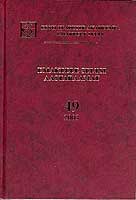EESTI KIRJAKEELE MÕTTERUUM
Standard Estonian as a space for thought
Author(s): Krista KergeSubject(s): Language and Literature Studies
Published by: Teaduste Akadeemia Kirjastus
Keywords: literary standard; standardization; language planning
Summary/Abstract: The treatise reflects on literary language as a manifestation of civilization. The standardization or codification of language begins with the creation of a phonetic script, for although the result is based on dialects, it cannot be identified with any of them. As time goes by, written texts come to cover ever more fields and subjects not discussed in dialects (in Estonia, one of such was religion, at first). A remarkable rise in literacy appears in the 18th century, as can be concluded indirectly from the publication of the full Bible and almanacs with an occasional circulation of about 20,000. This is evidently the period when the intersection of the dialects begins to grow and the base is laid for standard Estonian as a lingua franca. A breakthrough arrives in the 19th century. Along with the national awakening and the rise of vernacular culture literacy becomes a common skill. And yet, it is not until the 20th century that an explosive growth can be observed in our space of thinking, defined by the texts written and read in Estonian, including those translated into it. Thus Estonian as a means of thinking and cognition becomes a modern European language providing for synchrony with the Western thought. In the course of but a few decades Estonian develops into a multifunctional language serving all public functions, providing for cultural diversity, general as well as academic education, and even science (only in 1920 Estonian becomes the language of tuition at Tartu University, yet already in 1938 the Academy of Sciences is founded). Standard Estonian also acquires the function of a means of informal communication, oral as well as written, the everyday use of which is prestigious, in contrast to the vernacular dialects. By the 1960s–1970s standard Estonian has become the naturally acquired L1, with social dialects developing within it. At the same time, regional dialects also develop a social characteristic, as under the circumstances of increased internal migration dialect speech is not so much a local means of communication as a means to emphasise one’s region of origin. So, standard Estonian functions as a socially appreciated code, having a levelling effect on group differences. A new change is introduced in the linguistic situation by the restoration of independence in the 1990s. There appears a peculiar functional contrast, as most of the input is in English, but the output should be in Estonian. In addition there come social stratification, globalization, and the new influences of media at large. Such a situation requires that language planning (that has strong traditions here anyway) as well as other branches of applied linguistics should considerably increase in importance. As a literary standard is, after all, artificial in a way, one cannot very well rely on its self-regulation, in particular if the number of its natural speakers is less than a million.
Journal: Emakeele Seltsi aastaraamat
- Issue Year: 2003
- Issue No: 49
- Page Range: 007-022
- Page Count: 15
- Language: Estonian

